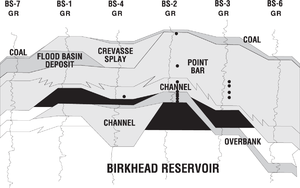Displacement pressure: theory vs. reality
| Exploring for Oil and Gas Traps | |

| |
| Series | Treatise in Petroleum Geology |
|---|---|
| Part | Predicting the occurrence of oil and gas traps |
| Chapter | Evaluating top and fault seal |
| Author | Grant M. Skerlec |
| Link | Web page |
| Store | AAPG Store |
Rarely is the actual column of trapped hydrocarbon compared with the prediction from measured displacement pressures. Empirical studies are needed because simple, idealized laboratory experiments show significant errors between the predicted and observed hydrocarbon column heights.[1] These experiments at best have column heights 19–23% larger than predicted. At worst, they are 125–217% larger than predicted. (The larger differences are probably the result of short equilibration times.)
Benton field
Benton field, Illinois, in one example in which the trapped column heights match the measured displacement pressure of the top seal.[2] Measured displacement pressures predict the top seal is capable of trapping 29–34 m (94–110 ft) of hydrocarbon. The actual column of hydrocarbon in the field in the Tar Springs Formation reservoir is length::29 m depth::(95 ft).
Bodalla South field

The Bodalla South field, Eromanga Basin, Australia, has short oil columns—less than length::12 m high—that appear to be limited by the displacement pressure of the top seal.[3] Figure 1 shows the top seal and oil accumulations. The top seal, the Birkhead Formation, consists of fluvial channel and point bar deposits as well as more shale-prone levee bank, crevasse splay, floodplain, and coal swamp facies. (See Lithofacies and environmental analysis of clastic depositional systems.) Measured displacement pressures of the top seal have an average range of 150–200 psi (air-mercury) and can seal 10.86–12.64 m of oil. The maximum height of the actual trapped oil column is depth::11.25 m.
Although predicted and observed data apparently agree, units within the top seal may be able to trap much greater oil columns. Measured displacement pressures of the shaly overbank facies are greater than pressure::3000 psi (air-mercury). These facies are not thought to be effective seals because they are either thin or lack lateral continuity.[3] More empirical studies are needed.
See also
- Seal capacity: pitfalls and limitations of estimation
- Saturations required for hydrocarbon flow
- Seal capacity of breached and hydrocarbon-wet seals
- Hydrodynamic flow and pressure transients
References
- ↑ Catalan, L., F. Xiaown, I. Chatzis, and F. A. L. Dullien, 1992, An experimental study of secondary oil migration: AAPG Bulletin, vol. 76, no. 5, p. 638–650.
- ↑ Sneider, R. M., and G. Bolger, 1993, Estimating seals from wireline logs of clastic seals and reservoir intervals, in J. Ebanks, J. Kaldi, and C. Vavra, eds., Seals and Traps: A Multidisciplinary Approach: AAPG Hedberg Research conference, unpublished abstract.
- ↑ 3.0 3.1 3.2 Boult, P. J., 1993, Membrane seal and tertiary migration pathways in the Bodalla South oilfield, Eronmanga Basin, Australia: Marine and Petroleum Geology, vol. 10, no. 1, p. 3–13., 10., 1016/0264-8172(93)90095-A